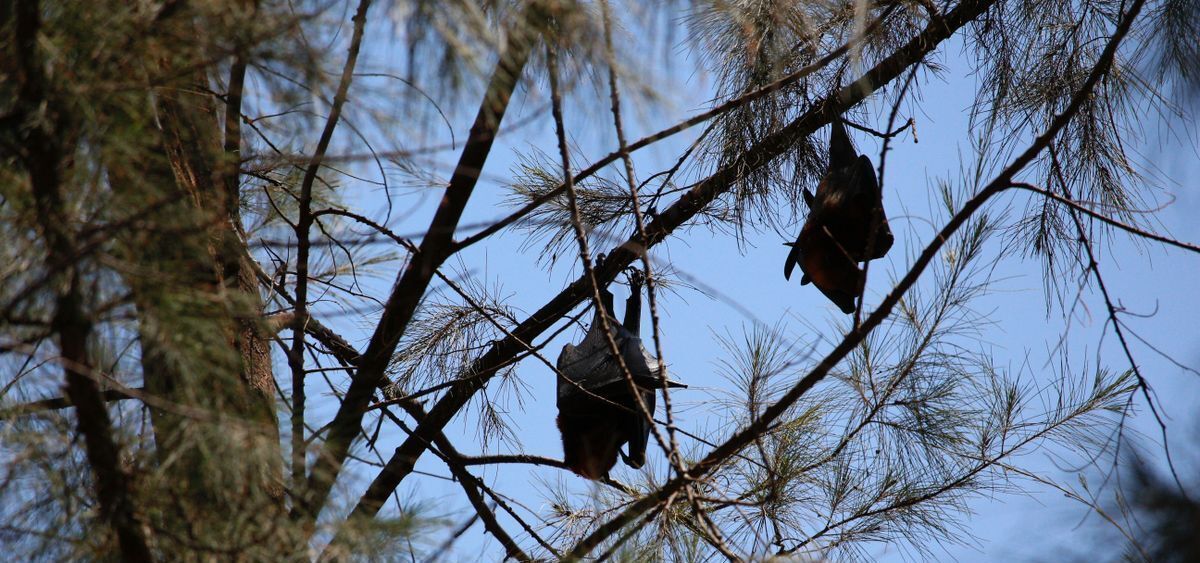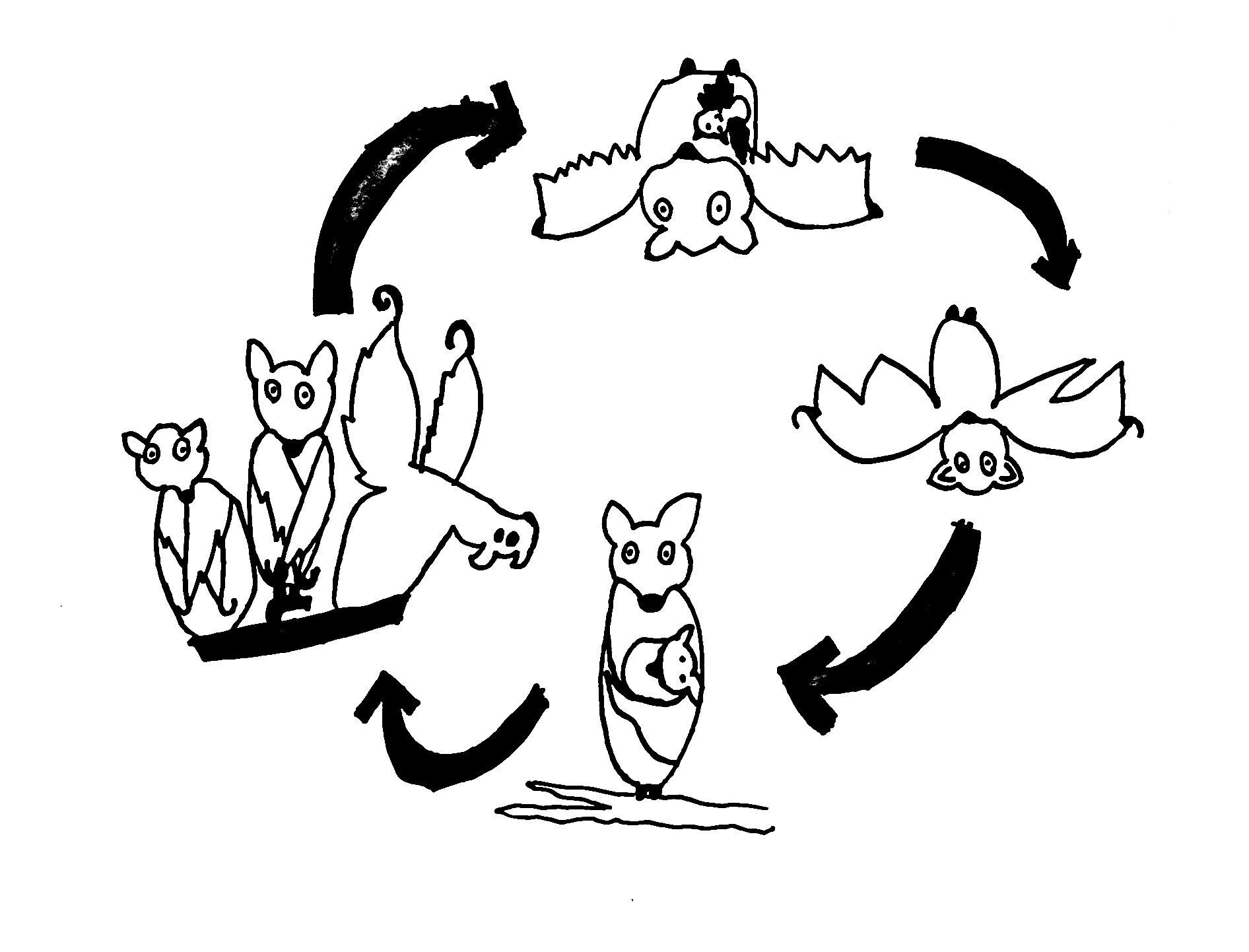
A BAT FOUND INDOORS
A bat that is found indoors is most likely to be a crevice-dwelling species. Although the fur color of crevice-dwelling bats varies, it is usually a shade of gray or brown. These bats are often lost youngsters or migrating bats. Oftentimes they will find their way out through an open window or door. If a bat is flying in a room you can help it find its way out through an open door by turning off the lights inside the room and shining a flashlight beam out the open door. Make sure doors to other rooms are closed off first and the only door open leads to the outside. If this is not an option, and if you feel confident that you can move the animal without physically touching it or injuring it, proceed to step one. Otherwise, proceed to step five.
1. WAIT UNTIL THE ANIMAL IS MOTIONLESS.
A bat that is flying is almost impossible to catch, and you have a greater chance of injuring the bat if you attempt to capture it while it is airborne. In addition, bats that are caught while flying frequently panic and attempt to bite. Be patient. Wait until the bat lands and is still, and then proceed to step 2.
2. CONTAIN THE BAT.
Quietly approach the bat, and wearing thick gloves or using a thick towel, gather the bat up (holding it securely but not tightly) and place it into a box or similar container with a lid. Or instead, simply place a box, waste can, coffee can or similar object over the bat where it has landed. Then, take a piece of cardboard and gently slide it between the box and the surface the bat is on (i.e. floor, wall or ceiling). Keeping the cardboard in place, gently turn the container right side up. If the bat is captured during the day proceed to step 5. If the bat is captured at night and does not appear to be a baby bat, proceed to step 3. Important note!: Do not place the bat in a bird cage or container with small openings. Bats are very intelligent and can easily squeeze through a 1/4 x 1/2 inch crack.
3. RELEASE THE BAT OUTDOORS AT NIGHTFALL.
Once the bat has been captured, take the container outdoors. Take a flashlight and a towel or gloves with you in case the bat has problems flying away. Find an elevated area (such as a deck or ladder), lift the box over your head, and tilt it to the side so the bat can fly out (the bat will not be able to fly out of a grounded container in a vertical position). Proceed to step 4. (Note: Do not release the bat during the day or during cold or bad weather. Instead, proceed to step 5).
4. WATCH THE BAT LEAVE.
Use the flashlight to watch the bat fly away. If the bat does not fly away, or attempts to fly but seems unable to, it is likely that is has an injury or illness. It may be a disoriented juvenile, or it may simply be dehydrated or starved from being trapped indoors. If this is the case, use the towel or gloves (not bare hands) to gather the bat up. Keep the bat in the closed container and put it in a safe place that is free of children, pets, fire ants or other hazards, and proceed to step 5.
A BAT FOUND OUTDOORS
Foliage-roosting bats have beautiful fur in shades of reds, yellows and tans (like dried leaves), or they have multi-colored fur that is frosted with white. These bats are frequently found on the ground in the early summer when mothers are moving their young, or when they become grounded following blue-jay attacks or storms. Occasionally, these bats panic and defend themselves when humans approach by spreading their wings in mock-attack and making loud hissing or clicking noises. Follow the steps given below to rescue a tree-roosting bat. If you feel unequipped to move the bat, proceed to step five. Note: If the bat is a gray or brown color, it is probably a crevice-dwelling species. Crevice-dwelling bats found out of doors and grounded will need to be examined and cared for by a wildlife rehabilitator.Place the bat into a container using the method described in “A Bat Found Indoors”, and proceed to step five.
1. MAKE SURE THE BAT IS SAFE FROM PREDATORS.
Have someone stand guard over the bat so it does not fall prey to domestic pets, fire ants or blue jays. If the bat remains quiet and still, proceed to step 2. If the bat panics as described above, proceed to step 5.
2. DO NOT USE YOUR HANDS TO HELP THE BAT. INSTEAD, GENTLY TOUCH A SMALL TREE BRANCH (TWO OR THREE FEET IN LENGTH) TO THE BATS FEET.
This usually initiates a grab reflex and the bat will grip the branch with its toes. When you lift the branch you can inspect the bat (or mother bat with babies) for any injuries. If the infants are clinging to the mother and there are no apparent injuries, proceed with step 3. If injuries are detected, proceed to step 5.
3. SLOWLY MOVE THE BATS INTO THE BRANCHES OF A NEARBY TREE.
This must be done very carefully. A sudden move may cause a mother bat to fly off and abandon her young. Using a ladder, gently secure the branch into a spot where foliage and leaves conceal the bats. The spot should be on a branch at least eight or more feet from the ground, with a clearing below to enable the bat to take flight. (Do not place the bats in the same tree where the attack may have occurred and do not place bats on the trunk of a tree where they will be vulnerable to predators. Also make sure there is no visible bird’s nest in the tree.) Proceed to step 4.
4. MONITOR THE AREA.
Check the area the following morning. If the bat has remained in the same position overnight it may have an undetected injury or illness. If the mother bat is gone but her babies remain, the babies may have been abandoned. Proceed to step 5.
5. CALL A LOCAL WILDLIFE REHABILITATOR FOR ASSISTANCE - Silent Voices has a Bat Specialist, Tama!
This information has been provided by our friends at Bat World Sanctuary. For more information on bats, please visit their website at the link below.









